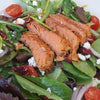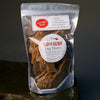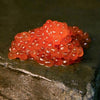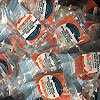Katsu sando is a popular Japanese dish that consists of a breaded and fried meat cutlet, typically pork or chicken, served between two slices of soft white bread and garnished with tangy tonkatsu sauce and crisp cabbage. However, for a tasty twist on this classic sandwich, we recommend trying a breaded salmon burger instead!
To make the perfect katsu sando with a breaded salmon burger, start by seasoning a salmon fillet with salt and pepper, then dredging it in flour, egg, and panko breadcrumbs. Fry the salmon until it's golden and crispy on the outside but still juicy and tender on the inside. Next, assemble your sandwich by spreading a generous amount of tonkatsu sauce on two slices of fluffy white bread, then layering on some shredded cabbage and a thick slice of your breaded salmon burger.
The result is a mouthwatering fusion of Japanese and Western flavors that's sure to satisfy anyone's cravings. Whether you're looking for a satisfying lunch or a quick and easy dinner option, a katsu sando with a breaded salmon burger is always a delicious choice!
[[ recipeID=recipe-8lj5zcr7r, title=Katsu Sando ]]



AUTHOR PROFILE
Nicole is the in-house Chef at Wild For Salmon as well as a Recipe Developer and Food Photographer from Allentown, Pennsylvania with an Associate degree from The Culinary Institute of America. Her first memories are of planting seeds with her father and grandfather in their elaborate gardens and sharing their abundant harvests with friends and neighbors. The spark of both pride and joy she felt when sharing this food with others and seeing the happiness it brought them was what inspired her to pursue the culinary arts from a young age. Nicole has spent time exploring the Hudson Valley and Philadelphia food scenes, but her current home in the rolling hills of Central PA is where she most enjoys combining her two passions; exploring the outdoors, and good food.




 Wild Alaska Salmon
Wild Alaska Salmon Alaska Salmon Burgers
Alaska Salmon Burgers Smoked Salmon & Seafood
Smoked Salmon & Seafood Wild Alaska Whitefish
Wild Alaska Whitefish Wild Shellfish & Shrimp
Wild Shellfish & Shrimp Wild Albacore Tuna
Wild Albacore Tuna Canned Seafood
Canned Seafood Meal Box & Samplers
Meal Box & Samplers Pet Products
Pet Products Gifts
Gifts Specialty
Specialty Wholesale Ordering
Wholesale Ordering
